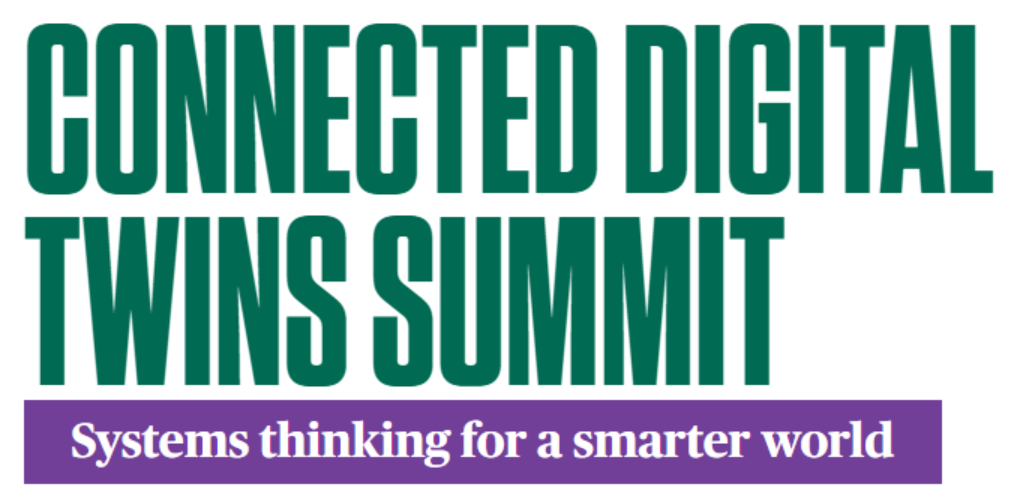Great things happen with digital twins and trusted data for our built environment
1Spatial work with organisations across the built environment to deliver increased productivity, reducing or avoiding costs and increasing output by delivering trusted data with automated information management. 1Spatial achieve positive outcomes for organisations by enabling the implementation of information management (data governance) frameworks for digital transformations, including digital twins.

Connected Digital Twins Summit
1Spatial are delighted to support the Connected Digital Twins Summit – Systems thinking for a smarter world, on 22nd June. The Digital Twin Hub and Connected Places Catapult are hosting a one-day hybrid event to showcase the latest cross-industry business applications for connected digital twins. Seb Lessware, CTO at 1Spatial, will be giving a thought-provoking presentation during the Gemini call live session. Seb will talk about how trusted data is critical to successfully developing and sustaining digital twins. Seb will present case studies, including the National Underground Asset Register (NUAR)
1Spatial’s vision is to help to make the world safer, smarter, and more sustainable by unlocking the value in information, enabling better decisions and greater insights. We are a global leader in information management, helping organisations build strong data foundations for improving the quality, availability, and timeliness of information available to organisations for positive outcomes through digital twins.
Information Management (IM) Frameworks
IM frameworks aim to establish the building blocks that are necessary to enable effective information management across the built environment throughout its lifecycle. IM frameworks enable secure, resilient interoperability of data, which is at the heart of digital twins. It is a reference point to facilitate data use in line with security, legal, commercial, privacy and other relevant trustworthy needs.
The Pathway Towards an Information Management Framework: A Commons for a Digital Built Britain, sets out the technical approach for the development of an Information Management Framework (IMF) to enable secure, resilient data sharing across the built environment. The publication of the report by the former Centre for Digital Built Britain is a key step towards a National Digital Twin. To guide the development of the IMF, nine values were set out by the Centre for Digital Built Britain. These values are known as the Gemini Principles.
- Purpose - Digital Twins must provide benefit to the general public, enable improvement in performance while creating value and must provide real insight into the built environment.
- Trust – This is a major part of the idea behind the National Digital Twin. A Digital Twin must enable security and be secure, it must be as open and transparent as possible, and built using legitimately good-quality data.
- Function - A digital twin must function effectively. A federation of digital twins must be based on a standard connected environment, there must be clear ownership of the twin, as well as clear governance and regulation. There is also a requirement for digital twins to adapt as the available technology continuously evolves.
A related IM framework is the UK BIM Framework (GIIG) Information Management Platform (IMP). The IMP sets out the steps organisations can take to develop a portfolio level digital information management strategy that can be progressively assembled from existing, and, if necessary, new enterprise systems, to capture and maintain an ISO 19650 compliant asset information model for each of its assets. The IMP can assist in an organisation, where relevant, in meeting stated government construction policy aims, namely, those contained in the Construction Playbook and Transforming Infrastructure Performance: Roadmap to 2030. An IMP is a cornerstone for the development of digital twins and future connected national digital twins.
The Environment Agency are adopting IMP as their IM framework for delivering reliable digital data and information management for their physical flood and coastal defence assets.
Delivering reliable digital data and information management for EA's physical flood and coastal defence assets
“1Spatial’s 1Integrate technology and Safe Software’s FME Server technology provides robust asset data and information assurance capabilities, to enable our strategic objectives and further digital transformation. The automated geoCOBie data assurance processes for collecting, collating, analysing, and sharing data appropriately on asset performance provides us with the insight we need to improve productivity and deliver benefits to society.” Karen Alford Flood and Coastal Risk Manager, Environment Agency

Information Management
Information Management (IM) is the process by which an organisation specifies, procures, receives, assures, stores (via a system of record) and presents its data to perform its core business across asset lifecycle activities. IM can occur without strict adherence to IM frameworks, but greatly benefits from its structure and process. IM is enabled by the application of information management frameworks and supports the development of trusted data for digital twins and future connected digital twins.
Accuracy, completeness, uniqueness, validity, timeliness, and consistency are all qualities of information that is enabled by the effective use of information management.
- Accuracy - data is correct in all details and is a true record of the entity it represents.
- Completeness – data has all or the necessary attribute values relative to its intended purpose.
- Uniqueness – a single representation exists for each entity or activity.
- Validity – data conforms to all standards expected.
- Timeliness – data is easily accessed or available when required and is up to date.
- Consistency – an entity that is represented in more than one data store can be easily matched.
1Spatial works with organisations across the built environment to ensure all the above qualities of information, enabled by the effective use of automated information management.
Business Operations
Business operations is the process of using trusted data and information to carry out organisational functions. Organisations responsible for the built environment use data and information to measure, model, monitor and manage.
Digital Twins
Digital Twins involves business model innovation, and operational improvement organisational changes. IM typically provides structured and accurate data to support the adoption of digital twins for operational improvements. Digital twins are used to improve measuring, modelling, monitoring, and managing.
The Environment Agency are adopting IM as part of their operational improvement journey towards a digital twin of their physical flood and coastal defence assets.
An IM (data governance) framework enabled by the application of information management frameworks and supports the development of trusted data for built environment operational improvements using digital twins and future connected digital twins.
Summary
IM frameworks, IM and digital twins are symbiotic.
An IM framework needs IM and IM needs an IM framework to support the development of trusted data. Digital twins need both IM frameworks and IM to succeed and enable great things to happen.
We look forward to discussing “great things happen with digital twins and trusted data for our built environment” further at the forthcoming Connected Digital Twins Summit in London.
Author: Matthew White, Head of Built Environment, 1Spatial

Want to know more?
Contact one of our experts today to explore how 1Spatial can help you.
Contact us
